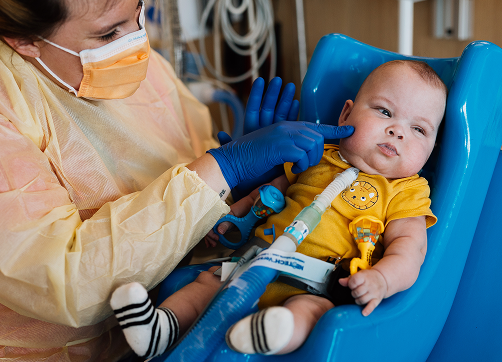pfeiffer syndrome


about condition
Pfeiffer syndrome is a genetic congenital condition characterized by skeletal malformations. Severity of symptoms varies among individuals from mild to severe. A key feature of Pfeiffer is the premature fusion of certain skull bones, called craniosynostosis, which affects the shape of the head. In addition, fingers and toes may be malformed (fused/webbed). Premature fusion of the skull bones prevents the head from growing as it should, which can lead to a sunken appearance in the middle of the face (midface hypoplasia). Other characteristics include protruding eyes, hearing loss and sometimes a high and/or narrow palate. In individuals with Pfeiffer syndrome, an underdeveloped upper jaw can lead to dental challenges, such as crowded teeth and even teeth present at birth in some cases.
symptoms
In medical literature, Pfeiffer syndrome has often been described as having three subsets or types (I, II and III), with each type having different severity, characteristics, and sometimes differing gene information. However, more recent research is suggesting that Pfeiffer syndrome no longer be described within those types, and instead be classified as one syndrome, ranging from mild to severe with an array of characteristics, even in one family. (Some research and speculation is suggesting the possible future discovery of a new and differently named syndrome once thought to be a type of Pfeiffer syndrome. It may be feasible since there are already existing similar and related syndromes to Pfeiffer.) Since this condition has such a broad array of characteristics, this is an overview of some of the possible symptoms:
- Mild to severe skull malformations (craniosynostosis)
- Different skull shapes, ranging to cloverleaf shape
- Shortened base of skull (anterior cranial base)
- Hydrocephalus (altered flow of cerebrospinal fluid causing accumulation and pressure on the brain)
- High and/or broad forehead
- Widely spaced eyes / mild to severe protrusion of eyes
- Flattened and underdeveloped midface, including the upper jaw / airway issues (sometimes needing surgical intervention)
- Beaked or other misshapen nose
- High and/or narrow palate
- Possible trachea narrowing and other trachea issues
- Prominent lower jaw
- Low-set ears / missing or narrow ear canals / other conductive hearing loss malformations
- Dental malformations / abnormal presence of teeth at birth (natal teeth)
- Elbow joint fixation and lack of mobility
- Possible abdominal internal organ malformations
- Normal intelligence with some / mental development and neurological complications with others

how do you treat Pfeiffer syndrome?
The treatment of Pfeiffer syndrome is focused on the specific symptoms apparent in each individual since the symptoms can vary so widely. Several specialties and physicians may be involved throughout the child’s life. Surgeries such as craniofacial and reconstructive may be necessary to correct skull and head malformations, as well as airway issues. Possibly additional surgeries to correct other skeletal malformations, along with surgical correction of fingers and toes. Patients may see some or all of the following physician specialties: otolaryngologist (ENT), audiologist, neurologist/neurosurgeon, ophthalmologist, dentist, orthodontist, oral surgeon, orthopedics and more. Early intervention may be important to ensure that children with this syndrome reach their full potential. Special services like physical and occupational therapies along with special education may be very beneficial.
FAQs
About pfeiffer syndrome
Very rare; this condition is estimated to only occur 1 of every 100,000 births. It affects males and females equally.
Yes, Pfeiffer syndrome is usually apparent at birth. It is an autosomal dominant condition, which means it can either be inherited from one parent or occur as a result of a new sporadic mutation change in the gene. Individuals with more severe Pfeiffer appear to result from new mutation changes. (Literature indicates that advanced paternal age is related to an increased risk for new mutation changes.) Any affected individual will have 50% chance of passing the syndrome on to future children.
Individuals with milder Pfeiffer syndrome generally have a typical life span. More severe individuals have more complications that could lead to a shortened life span.
Sometimes when an ultrasound is performed during pregnancy, a doctor may notice non-typical signs which require additional testing. More in-depth testing with 2D or 3D ultrasounds or a fetal MRI can reveal much more detail. After birth, clinical examinations, CT scans, MRI, and other testing can help to diagnose the syndrome.
If one of the parents is affected, during the pregnancy more in-depth testing can be done earlier to possibly rule out the syndrome. For genetic purposes, it is helpful if the affected parent has already been tested and their positive mutation change ‘location’ has been found. The location is the area in the gene where the positive mutation change occurs. A good way to think about this is finding a letter typo on a page within a book; that’s the exact location. Therefore, if the affected parent has received their mutation change information from their genetics department, it will be straightforward to look in the exact same location for the fetus to find, or rule out, a positive mutation. In dominant genetic conditions, positive mutations appear in the same location (same page letter typo) for all family members for that condition. Genetic counseling is highly recommended for any individual with Pfeiffer syndrome having or considering a future family. If your mutation is found, always retain a copy of the genetics report from the genetics department for safekeeping.
Genetic mutation changes in FGFR1 (fibroblast growth factor receptor-1) and FGFR2 (fibroblast growth factor receptor-2) are responsible for this syndrome. (These genes are also known for causing similar syndromes.)
The genes that cause this condition to occur play an important and critical role in skeletal development. Genes give instructions for creating the proteins that play vital roles in our body. When a mutation change in a gene happens, the protein that is important for building structures is disrupted. When a genetic change happens in FGFR1 or FGFR2, it results in these receptors not communicating properly with fibroblast growth factors. This means the sutures in the brain do not form as they should, so consequently, this can disrupt the development of other structures in the body. Since different mutation changes are known for causing Pfeiffer, they can cause different malformations; therefore, individuals will vary in presentation.
- Acrocephalosyndactyly, type V
- ACSV
- Craniofacial-skeletal-dermatologic syndrome
- Noack syndrome
- Apert syndrome
- Crouzon syndrome
- Jackson-Weiss syndrome
- Beare-Stevenson syndrome
- Muenke syndrome
- Saethre-Chotzen syndrome
related blogs
here when you need us
Whether you’re looking for the right provider, ready to make an appointment, or need care right now—we’re here to help you take the next step with confidence.

